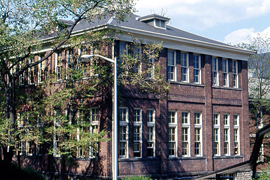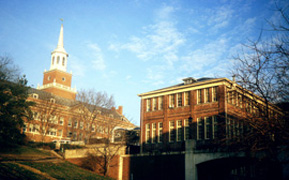A HISTORY OF OLD TECH
Goetzman & Folmer,
Architects
June 1982
"Old Tech” was built as a result of an agreement
between the University of Cincinnati and the Technical School of Cincinnati, a
manual training school. The Board of Directors of the Technical School offered to
give the University its equipment and charter provided the University would
operate the school as the Technical School of the College of Engineering. The
trustees of the Technical School further helped facilitate this agreement by
raising the money to construct a building on University grounds. James E.
Mooney was one of the principal donors.
A report by Howard Ayers, President of the Board of
Directors of U.C. on June 24, 1901 states "…..a
building thoroughly adapted to the needs of Manual Training and Technical
Instruction would form an integral part of our School of Engineering and
furnish the preliminary and indispensable shop-training in wood and metal work,
which all of our Engineering students are required to have. In the second
place, it would constitute a portion of the experimental course of the Teachers
College, and thus serve an important purpose not only in properly training
teachers for their profession, but also in giving them adequate practical
experience in the fundamental principles of their professional work. The
University would maintain the Manual Training course of study of the Technical
School until such time as the Board of Education of Cincinnati shall establish
a satisfactory Manual Training High School or other Manual Training School in
this city."
Cost of the building was estimated to be $12,430.00. It was believed that it would be relatively inexpensive to operate because it would utilize heat, light and power provided by the University's existing plant (The Commons) and because the administration would be handled by the Engineering Department. By the fall of 1901 the foundation was laid and by March of 1902 the building was ready for use, but in 1907 the Technical School was discontinued and the building and equipment were turned over completely to the College of Engineering. When Baldwin Hall was built in 1912, most of the engineering facilities were moved. The Geology and Geography Department grew eventually to complete occupancy of the structure.
 |
 |
Two years later architects Tietig
and Lee produced drawings to balance off the building by adding a second story
to the south wing. This time exterior walls were taken down all the way to the
top of the basement foundation. Stairs to the basement were removed from the inside and the north areaway deepened to allow steps down on the outside in
their present location. It was at about this same time that reinforced concrete
was coming into common use, so whereas the north addition was done like the
main building with wood joists and steel beams, the south wing used reinforced
concrete columns and beams and floor panels.
The drawings of 1909 also show that the recently added
partitions, toilet room, and stair on the first floor of the north wing were
now being removed. Only one office and a large room remained. The toilet room
reappeared on the second floor where the stair had been. Two of the second
floor classrooms were combined into one and a corridor ran through to a new
fire escape on the east side. The top floor on the south side was partitioned
off in a fashion similar to the north side with an office taking the place of
the toilet room. The first floor was left without partitions. The large lecture
room in the center of the building was part of this phase as well as the stone
portico centered in the east facade, which gives outside access to it. It also
included the addition of a classroom in the second floor roof space where the
skylight had been. Second floor classrooms were also reduced in size to allow
for a corridor into the wings. It was also at this time that the arches were
removed from the windows of the building's center section and openings raised
to duplicate those of the wings.
At the end of this phase of construction the elements of
the exterior looked almost exactly as they do today. Likewise the second floor
was much as it is now. The main exception is that the fire escapes on the east
side and the corridors to them were eliminated with new escapes (existing)
being located on the west side.
The first floor has been in more of a state of flux with
partitions being added, removed and added once again. The museum first appears
on 1913 drawings in only the west side of the south wing, then shifts to the
north wing where it was later divided and then relocated in its present
position in the south wing. It was torn down in 1990 to make room for a wall and some lawn.